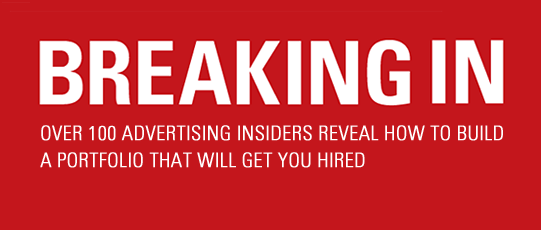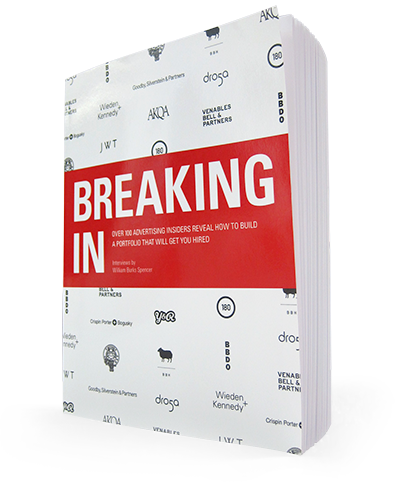Jason Bagley is Creative Director at Wieden+Kennedy, Portland.
Old Spice – “Internet Response Videos”
Oreo – “Whisper Fight”

 Follow on Twitter
Follow on Twitter
Jason Bagley is Creative Director at Wieden+Kennedy, Portland.
Old Spice – “Internet Response Videos”
Oreo – “Whisper Fight”
Read the full interview in BREAKING IN: Learn more about the book or Buy it on Amazon
Jason Bagley is Creative Director at Wieden+Kennedy, Portland.
Dikembe Mutombo’s 4 1/2 Weeks to Save the World
Nike – “Fate”
Read the full interview in BREAKING IN: Learn more about the book or Buy it on Amazon
Jason Bagley is Creative Director at Wieden+Kennedy, Portland.
Old Spice – “The Man Your Man Could Smell Like”
Old Spice – “Muscle Music”
Read the full interview in BREAKING IN: Learn more about the book or Buy it on Amazon
Check out some great work from Luke Sullivan.
WS: What do you look for in a student portfolio? And what impresses you?
LS: Okay, so I was just interviewing a kid for his first job, right? Kid had just gotten out of a very good ad school. As we clicked through his book he said, “I’m sorry there’s not much advertising in here, but…” I interrupted him and said, “Dude, you had me at ‘sorry.’” No, there wasn’t a lot of advertising in there. But his book was filled with fascinating things, interesting content, and yes, pretty much everything except what I might call traditional advertising. And I loved it. What a book needs isn’t cool advertising. Just cool creative stuff. Yes, ultimately the work needs to have some sort of a commercial aspect to it, it has to report to some sort of purpose, some strategy…but show me something cool, something interesting, that’s what I need to see.
WS: How important is finish? Can sketches be enough?
LS: The short answer is, if your ideas are incendiary—I mean if they are hair-curlingly great—yes, you probably can get away with a less-than-finished look. But when you have a less-than-polished book, well, you have human nature working against you. It may not seem fair, but the better-looking books have an advantage. It has ever been thus. Remember the handsome stupid guys in high school? Dumb as a bag of scissors, and they still attracted all the great girls? Get over it. Anyway, I don’t care how you do it, but find a way to make your great ideas look like great ideas. I’m not talking about kick-ass finished art, but if you can go a level or two beyond stick figures, go for it.
Read the full interview in BREAKING IN: Learn more about the book or Buy it on Amazon
Luke Sullivan is Advertising Chair at Savannah College of Art & Design and Author of “Hey Whipple, Squeeze This”.
PETA
Dunwoody – “Recycled Resumes”
Miller Lite – “Customized Commercial”
Read the full interview in BREAKING IN: Learn more about the book or Buy it on Amazon
Check out some great work from Rob Reilly.
WS: What do you look for in a student book? And what impresses you?
RR: It’s hard these days. And I’m sure students are trying to figure out the secret formula. There really isn’t one. In the end, a good idea is what landed you a job 20 years ago and it is most likely the thing that will land you a job today.
WS: How important is finish? If ideas are the most important thing, can sketches be enough? Do you look at actual books anymore, or is it all websites?
RR: I personally like paper books. Though I will look at a website if it loads fast and it is easy to navigate. If you can’t go to finish on stuff and just have sketches, you better be damn sure you have the greatest idea ever.
WS: How important is copy? Do you need to see long-copy ads?
RR: The ability for a copywriter to write is incredibly important. More and more, brands are asking agencies to write their stories. Writing a narrative is difficult. But if you are good at it you will have a long career.
WS: What do you think of showing work that is not advertising?
RR: It is always helpful to have more than less.
WS: Do you have any other advice for a student or junior trying to get into the business, either in putting together a book or how to actually start looking for jobs?
RR: Internships are very important. You learn a lot and you actually get to talk to people who have successfully done the very thing you are trying to do.
Read the full interview in BREAKING IN: Learn more about the book or Buy it on Amazon
Rob Reilly is Worldwide Chief Creative Officer at Crispin Porter + Bogusky.
MINI – Counterfeit MINIs
Burger King – “Whopper Freakout Case Study”
Read the full interview in BREAKING IN: Learn more about the book or Buy it on Amazon
Check out some great work from Nigel Roberts.
WS: What do you look for in a student book? And what impresses you?
NR: Ideas that want to stand out, that are original, rather than just emulating what’s already out there at the moment. And intelligence. Stuff that doesn’t just tell you a gag vaguely connected with a product, but gives you some reason to be more interested in the product than you were before, and more likely to want to buy it.
[ … ]
WS: Do you think writers need to have a long-copy ad in their books to show they can write, and do you think art directors should have long copy in their books to show they can lay it out?
NR: I don’t think it’s essential, no. I don’t think many people will take the time to read long copy in a portfolio anyway, because time is tight. The copywriting skills of a junior copywriter—-to be able to write long copy-—is something that you can tackle once you’re in the job. But you must show that you are capable of writing headlines. You need to show a good enough command of the language to be able to express what you need to in a concise, persuasive way.
WS: What do you think about including things in a book that aren’t ads?
Read the full interview in BREAKING IN: Learn more about the book or Buy it on Amazon
Nigel Roberts is Creative Director at Leagas Delaney, London.
UK Central Office of Information
The Economist
Read the full interview in BREAKING IN: Learn more about the book or Buy it on Amazon
Check out some great work from Kim Papworth.
WS: Do you like to see finished work or do you like to see sketches or do you care?
KP: I suppose I would start by saying I don’t particularly care. I’m looking for all those other things. However, I’ve learnt through…especially when you’re working on Pan-European pieces of work—the word “texture” is very important. Because things can get lost in translation and quite often having too much language is a nightmare so you’re better off keeping things very simple and creating strong textures that make people feel things. And some understanding of, again, that ability to show different tones is important, I think. So years ago, yes, you could go around with just little drawings in your book and it didn’t matter how bad or good they were. I think it just shows a level of understanding if you have got some stuff. But I wouldn’t say that I want a book where everything is finished to a very high standard. I’m quite happy to see some campaigns that are very sketchy and loose and maybe just a couple that are finished up or even one that’s finished up. I think I’d rather have that. Because sometimes, you know, books should be “working books.” And if something’s too finished up, it’s like, well, what you’re telling me is that that’s the finished thing. Whereas if it’s in a sketchy stage, it feels a bit more malleable and I think people talk about it in the more creative way. Because if it’s too finished, it’s like, “Well, yes, I do like that one,” “Well no, I don’t like that one.” Whereas if it’s a bit loose you go, “Oh, that’s interesting! Have you thought about this?” You know, you have a different conversation.
Read the full interview in BREAKING IN: Learn more about the book or Buy it on Amazon